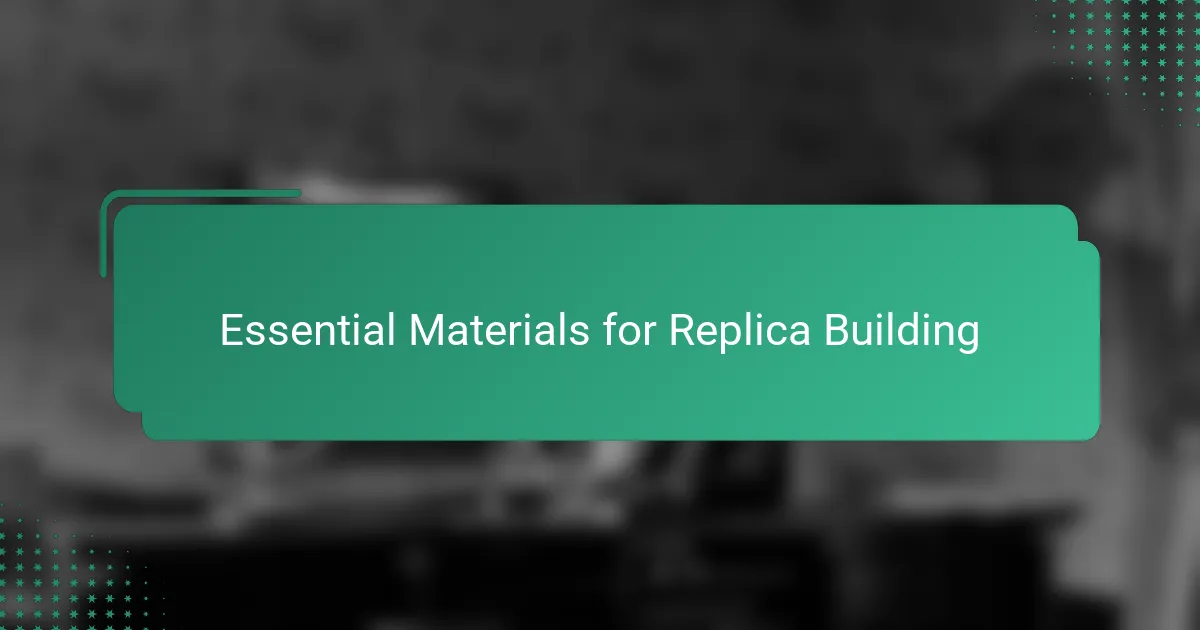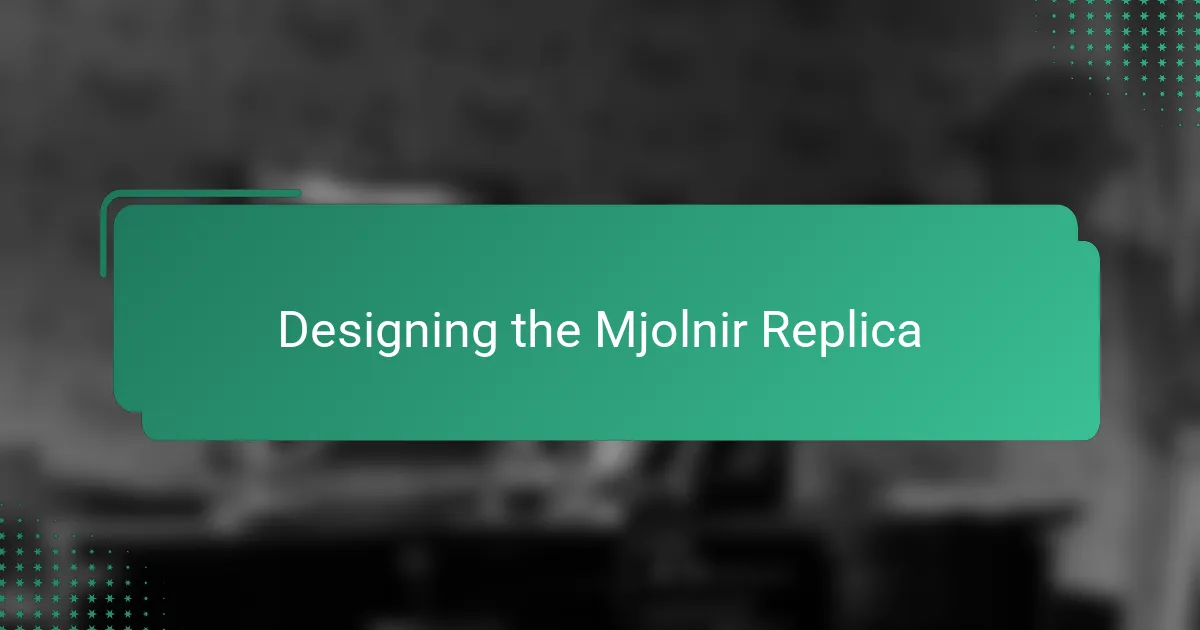Key takeaways
- Science fiction props serve as storytelling tools that blend creativity and craftsmanship, inviting exploration of imaginative worlds.
- Choosing the right materials, such as EVA foam and resin, is crucial for creating durable and authentic replicas.
- The design process is essential for capturing a prop’s character, making it a tangible link to the stories they represent.
- Effective painting and display techniques enhance the character and integrity of the replica, transforming it into a captivating showcase piece.

Understanding Science Fiction Props
Science fiction props fascinate me because they bring imagined worlds into tangible reality. They’re not just objects; they’re storytelling tools that carry the essence of entire universes in their design. Have you ever held a prop that made you feel like you were part of that story? That’s the magic I aim to capture.
What’s striking about these props is their blend of creativity and craftsmanship. Often, they require understanding materials and techniques that go beyond everyday skills. For me, diving into these challenges turns prop-making into a thrilling puzzle—one that tests both my imagination and technical know-how.
Beyond their visual appeal, science fiction props invite us to explore “what if” scenarios. They represent technologies and ideas that don’t exist yet, sparking curiosity about the future. Crafting such a prop isn’t just about replication; it’s about imagining the possibilities that inspired the original creators and making those dreams feel real.

Essential Materials for Replica Building
When I started building my Mjolnir replica, selecting the right materials felt like the foundation of the entire project. I knew I needed something sturdy for the hammerhead—something that could mimic metal without weighing me down. Foam and resin quickly became my go-to choices because they balance durability and manageability perfectly.
Have you ever worked with EVA foam? For me, it’s a prop builder’s best friend. It’s lightweight, flexible, and easy to shape, which made carving the intricate details of Mjolnir less daunting. But foam alone wouldn’t give the solidity I wanted, so layering it with resin created that perfect hard shell that catches the light just right.
Then there’s the handle. I wanted it to feel authentic when held, so I picked wood for its natural grip and weight. Wrapping it tightly with leather strips added both comfort and that classic Norse vibe. Choosing materials that engage the senses—touch, weight, even sound—really brought the replica to life for me. Have you noticed how the right materials transform a simple prop into something you almost believe in?

Tools Needed for Prop Creation
When I gathered my tools for creating Mjolnir, I quickly realized that having the right ones made all the difference. For shaping the EVA foam, a sharp hobby knife became my constant companion—its precision helped me carve the sharp edges I needed without frustrating slips. Have you ever felt that satisfaction when a blade just glides through the material, turning rough shapes into refined details? That’s the kind of moment I live for in prop-making.
Besides cutting tools, power tools like a rotary tool with sanding bits were indispensable for me. They allowed me to smooth surfaces and add subtle textures that brought the hammerhead from a simple block into a weathered, ancient artifact. Using these tools felt like giving Mjolnir its character, as if I was breathing life into the storm god’s weapon.
I also leaned heavily on some unexpected items—like heat guns for shaping foam and clamps to hold glued parts firmly as they dried. These might sound basic, but without them, the assembly could have turned into a messy disaster. In my experience, prop creation is as much about patience and the right tool at the right time as it is about skill. Have you ever felt how the smallest tool can save hours of frustration? That’s something every builder learns fast.

Designing the Mjolnir Replica
Designing the Mjolnir replica was where my vision started to take shape. I spent hours pouring over reference images, trying to capture not just the hammer’s form but its soul—the runes, the weathered textures, and that unmistakable balance between might and mystery. Have you ever stared at a prop so closely that you begin to see it as more than just an object? That’s how I felt drafting each sketch.
Translating those designs into something buildable was a real challenge. I broke down the hammer’s complex shapes into manageable sections, planning for the curves and angles that would make Mjolnir instantly recognizable. It was a bit like solving a puzzle—how to keep the integrity of the original design while working within the limits of my materials and tools.
What surprised me most was how much personality emerged during design. Each detail, from the grip’s leather wrap to the subtle beveled edges on the hammerhead, wasn’t just decoration—it told part of Mjolnir’s story. Designing it made me think about how props aren’t just replicas; they’re tactile links to the worlds we love. Have you ever caught yourself imagining the history behind a prop’s every scratch and dent? Designing Mjolnir definitely sparked that for me.

Step by Step Construction Process
The first step I took was cutting the EVA foam into the basic shape of Mjolnir’s hammerhead. I remember feeling a mix of excitement and nerves as I traced the patterns—would my cuts be precise enough to reflect the sharp, iconic edges? It was less about rushing and more about carefully sculpting each piece to fit perfectly.
Once the shapes were ready, I layered them with resin to add rigidity. At this stage, patience became my closest ally. Waiting for each coat to dry felt like a test of commitment, but watching the foam transform into something almost metallic made every minute worth it. Have you ever experienced that satisfaction when a fragile material suddenly looks solid and real?
Attaching the handle was its own adventure. Shaping and sanding the wood to fit snugly into the hammerhead took some trial and error. Wrapping the leather was a meditative process—I found myself imagining Thor gripping his hammer, ready for battle. It’s funny how these little touches make the replica feel less like a project and more like a piece of a myth come to life.

Painting and Finishing Techniques
Painting Mjolnir was where I got to play with color and texture, turning raw materials into something that felt ancient yet powerful. I started with a base of metallic silver spray paint—because nothing screams “magic hammer” like that gleaming metal look. Have you ever noticed how the right base coat sets the entire mood? It’s like giving your prop its first heartbeat.
After the base, I layered on weathering techniques to give Mjolnir that battle-worn authenticity. Using black and brown washes, I selectively darkened crevices and edges, simulating years of use and storms weathered. Applying these washes felt almost meditative, like I was telling a story through grime and wear rather than shiny perfection. Don’t you think props gain more character when they don’t look brand new?
Finally, sealing everything with a matte clear coat was a game-changer. It dulled any unwanted shine and protected my paintwork from scratches during handling. I remember nervously watching the spray mist settle—would it preserve the delicate details or wash them away? Luckily, that finish made Mjolnir feel ready for its next adventure in any sci-fi saga.

Tips for Displaying Your Replica
Displaying your Mjolnir replica felt just as important to me as building it. I chose a sturdy shelf with soft lighting that highlights the hammer’s details without harsh glares—have you ever noticed how lighting can transform a display from plain to spectacular? It’s like setting the stage for your prop’s story to unfold anew every time you look.
I also found that mounting Mjolnir on a custom wooden stand not only kept it safe but gave it a commanding presence. There’s something satisfying about seeing your creation “rest” as if it’s ready to be wielded at a moment’s notice. Have you tried balancing practicality with presentation? For me, that balance made all the difference.
Lastly, don’t underestimate the power of context. Surrounding Mjolnir with related memorabilia or even a backdrop inspired by Asgard created an immersive scene that made the display pop. It’s more than just showing off your work—it’s inviting others into the world you lovingly recreated. I’ve noticed that sharing these displays sparks conversations and connects us with fellow fans in a special way.


